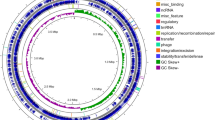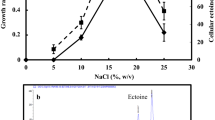Abstract
Ectoine, a cyclic tetrahydropyrimidine (2-methyl-1,4,5,6-tetrahydropyrimidine-4-carboxylic acid), is a natural compound, which serves as a protective substance in many bacterial cells. In this study, the putative ectABC gene cluster from Bacillus halodurans was heterologously expressed in E. coli and the production of ectoine was confirmed by HPLC analysis. The activity of the enzymes coded by the ectA, B and C genes were found to be higher in induced transgenic cells compared to the uninduced cells. Phylogenetic analysis revealed sequence identities ranging from 36–73% for ectA gene, 55–81% for ectB gene and 55–80% for ectC gene indicating that the enzymes are evolutionarily well conserved.




Similar content being viewed by others
References
Bradford MM (1976) A rapid and sensitive method for the quantitation of microgram quantities of protein utilizing the principle of protein-dye binding. Anal Biochem 72:248–254
Brown AD (1976) Microbial water stress. Bacteriol Rev 40:803–846
Burg MB (1997) Renal osmoregulatory transport of compatible organic osmolytes. Curr Opin Nephrol Hypertens 6:430–433
Chen TH, Murata N (2002) Enhancement of tolerance of abiotic stress by metabolic engineering of betaines and other compatible solutes. Curr Opin Plant Biol 5:250–257
Da Costa MS, Santos H, Galinski EA (1998) An overview of the role and diversity of compatible solutes in Bacteria and Archaea. Adv Biochem Eng Biotechnol 61:117–153
Galinski EA, Truper HG (1994) Microbial behavior in salt stressed ecosystem. FEMS Micribiol Rev 15:95–108
Horikoshi K (1999) Alkaliphiles: some applications of their products for biotechnology. Microbiol Mol Biol Rev 63:735–750
Kuhlmann AU, Bremer E (2002) Osmotically regulated synthesis of the compatible solute ectoine in Bacillus pasteurii and related Bacillus spp. Appl Environ Microbiol 68:772–783
Laemmli UK (1970) Cleavage of structural proteins during the assembly of the head of bacteriophage T4. Nature 227:680–685
Lentzen G, Schwarz T (2006) Extremolytes: natural compounds from extremophiles for versatile applications. Appl Microbiol Biotechnol 72:623–634
Lippert K, Galinski EA (1992) Enzyme stabilization by ectoine like compatible solutes: protection against heating, freezing and drying. Appl Microbiol Biotechnol 37:61–65
Louis P, Galinski EA (1997) Characterization of genes for the biosynthesis of the compatible solute ectoine from Marinococcus halophilus and osmoregulated expression in Escherichia coli. Microbiology 143:1141–1149
Muller V, Spanheimer R, Santos H (2005) Stress response by solute accumulation in archaea. Curr Opin Microbiol 8:1–8
Nagata S, Wang YB (2001) Accumulation of ectoine in the halotolerant Brevibacterium spp. JCM 6894. J Biosci Bioeng 91:288–293
Nuno E, Costa MS (2006) Diversity and biosynthesis of compatible solutes in hyper/thermophiles. Int Microbiol 9:199–206
Ono H, Sawada K, Khunajakr N, Tao T, Yamamoto M, Hiramoto M, Shinmyo A, Takano M, Murooka Y (1999) Characterization of biosynthetic enzymes for ectoine as a compatible solute in a moderately halophilic eubacterium, Halomonas elongata. J Bacteriol 181:91–99
Peters P, Galinski EA, Truper HG (1990) The biosynthesis of ectoine. FEMS Microbiol Lett 71:157–162
Reshetnikov AS, Khmelenina VN, Trotsenko YA (2006) Characterization of the ectoine biosynthesis genes of haloalkalotolerant obligate methanotroph “Methylomicrobium alcaliphilum 20Z”. Arch Microbiol 184:286–97
Roberts MF (2005) Organic compatible solutes of halotolerant and halophilic microorganisms. Saline Systems 1:1–30
Santos H, Da Costa M (2002) Compatible solutes of organisms that live in hot saline environments. Environ Microbiol 4:501–509
Sauer T, Galinski EA (1998) Bacterial milking: a novel bioprocess for production of compatible solutes. Biotechnol Bioeng 57:306–313
Schubert T, Maskow T, Benndorf D, Harms H, Breuer U (2007) Continuous synthesis and excreation of the compatible solute ectoine by a transgenic, nonhalophilic bacterium. Appl Environ Microbiol 73:3343–3347
Severin J, Wohlfarth A, Galinski EA (1992) The predominant role of the recently discovered tetrahydropyrimidines for the osmoadaptation of halophilic eubacteria. J Gen Microbiol 138:1629–1638
Takami H, Horikoshi K (1999) Reidentification of facultatively alkaliphilic Bacillus spp. C-125 to Bacillus halodurans. Biosci Biotech Biochem 63:943–945
Thompson JD, Gibson TJ, Plewniak F, Jeanmougin F, Higgins DG (1997) The CLUSTAL X windows interface: flexible strategies for multiple sequence alignment aided by quality analysis tools. Nucleic Acids Res 25:4876–4882
Vargas C, Jebbar M, Carrasco R, Blanco C, Calderon MI, IgIesias-Guerra F, Nieto JJ (2006) Ectoines as compatible solutes and carbon and energy sources for the halophilic bacterium Chromohalobacter salexigens. J Appl Microbiol 100:98–107
Welsh DT (2000) Ecological significance of compatible solute accumulation by microorganisms: from single cells to global climate. FEMS Microbiol Rev 24:263–290
Acknowledgments
Authors are grateful to the Director, Central Institute of Fisheries Technology (CIFT), Cochin for providing the necessary facilities to carry out this research work and Indian Council for Agricultural Research, New Delhi, India for financial assistance.
Author information
Authors and Affiliations
Corresponding author
Additional information
Communicated by Ercko Stackebrandt.
Rights and permissions
About this article
Cite this article
Rajan, L.A., Joseph, T.C., Thampuran, N. et al. Characterization and phylogenetic analysis of ectoine biosynthesis genes from Bacillus halodurans . Arch Microbiol 190, 481–487 (2008). https://doi.org/10.1007/s00203-008-0397-z
Received:
Revised:
Accepted:
Published:
Issue Date:
DOI: https://doi.org/10.1007/s00203-008-0397-z




